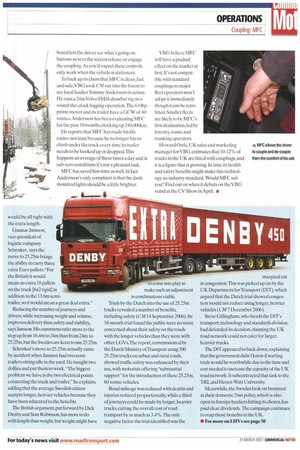SWEDISH MESSAGE
Page 62

Page 63

If you've noticed an error in this article please click here to report it so we can fix it.
Campaigners should look to Sweden to weigh up the pros and cons of longer, heavier truc(s Kevin Swallow explains.
he Swedes and the English seem to have a mutual admiration society.
They love our comedy, have English pubs and the majority of Swedes under 50 speak English; we reciprocate with our fondness for ABBA,Ikea,UIrikaJohnsson and Sven Goran Eriksson.
Yet throughout the heated debate with the government over the introduction of 25.25m trucks to our roads, UK hauliers have failed to cite the Swedish model as an example of how and why we should welcome longer vehicles here.
The Swedes have been operating at 24m long enough to know its advantages. And having witnessed their manoeuvrability and parking in average sized yards it seems to us that even less experienced drivers would be all right with the extra length.
Gunnar Jansson, vice-president of logistic company Schenker, says the move to 25.25m brings the ability to carry three extra Euro pallets:"For the British it would mean an extra 18 pallets on the truck [6x2 rigid l in addition to the 13.6m semitrailer,so it would mean a great deal extra."
Reducing the number ofjoumeys and drivers, while increasing weight and volume, improves delivery time, safety and viability saysjansson. His comments refer more to the step up from 16.4m to 24m than from 24m to 25.25m, but the Swedes are keen to use 25.25m.
Schenker's move to 25.25m actually came by accident when Jansson had two semitrailers sitting idle in the yard. He bought two dollies and put them to work."The biggest problem we have is the two electrical points connecting the truck and trailer," he explains, adding that the average Swedish citizen accepts longer, heavier vehicles because they have been educated to the benefits.
The British argument, put forward by Dick Denby and Stan Robinson, has more to do with length than weight, but weight might have to come into play to make such an adjustment in combinations viable.
Trials by the Dutch into the use of 25.25m trucks revealed a number of benefits, including safety (CM 14 September 2006). Its 18-month trial found the public were no more concerned about their safety on the roads with the longer vehicles than they were with other LGVs.The report, commissioned by the Dutch Ministry of Transport using 300 25.25m trucks on urban and rural roads, showed traffic safety was enhanced by their use, with motorists offering "substantial support" for the introduction of these 25.25m, 60-tonne vehicles.
Road mileage was reduced with deaths and injuries reduced proportionally, while a third of joumeys could be made by longer, heavier trucks, cutting the overall cost of road transport by as much as 3.4 %.The only negative factor the trial identified was the marginal cut in congestion.This was picked up on by the UK Department for Transport (DIT), which argued that the Dutch trial showed congestion would not reduce using longer, heavier vehicles (CM 7 December 2006).
Steve Gillingham, who heads the DIT's transport, technology and standards division, had defended its decision, claiming the UK road network could not cater for larger, heavier trucks.
The Df l' appeared to back down, explaining that the government didn't know if starting trials would be worthwhile due to the time and cost needed to increase the capacity of the UK road network. It subcontracted that task to the IRL and Heriot-Watt University.
Meanwhile, the Swedes look on bemused as their domestic 24m policy, which is also open to foreign hauliers hitting its shores, has paid clear dividends. The campaign continues to reap those benefits in the UK.
• For more on LI-IVN Nee page 50


























































































































































































